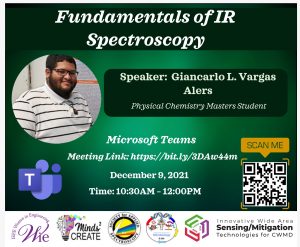DHS ARI IWAS introduced its 4th webinar on December 9, 2021 teaching undergraduate and graduate students the fundamentals of IR spectroscopy.

Infrared (IR) spectroscopy is a analytical technique that uses infrared radiation to identify and study the molecular structure and properties of materials. Infrared radiation is a type of electromagnetic radiation with a longer wavelength than visible light, and is invisible to the human eye. When infrared radiation is absorbed by a molecule, it can cause the molecule to vibrate, and the vibrational modes of the molecule can be used to determine its structure and properties.
Infrared spectroscopy is a non-destructive and non-invasive technique that can be used to study a wide range of materials, including liquids, gases, solids, and biological samples. It can provide detailed information about the chemical composition, structure, and dynamics of the material, and can be used for a variety of applications, such as material identification, quality control, and medical diagnosis. Overall, infrared spectroscopy is a powerful analytical technique that can provide valuable information about the molecular structure and properties of materials.






